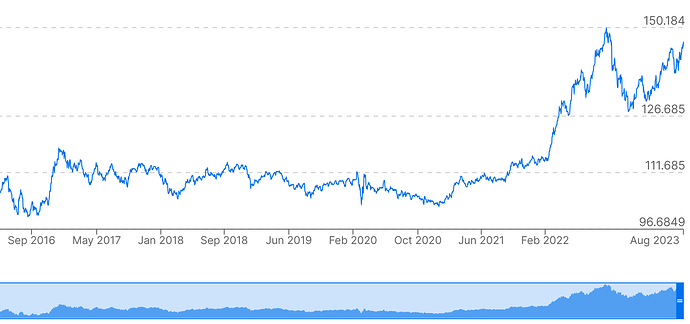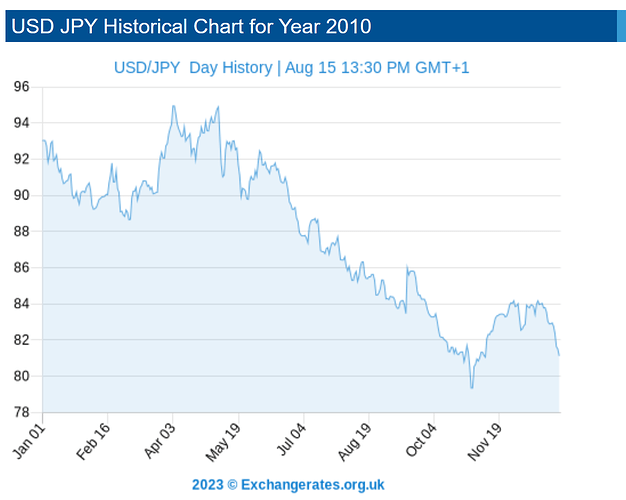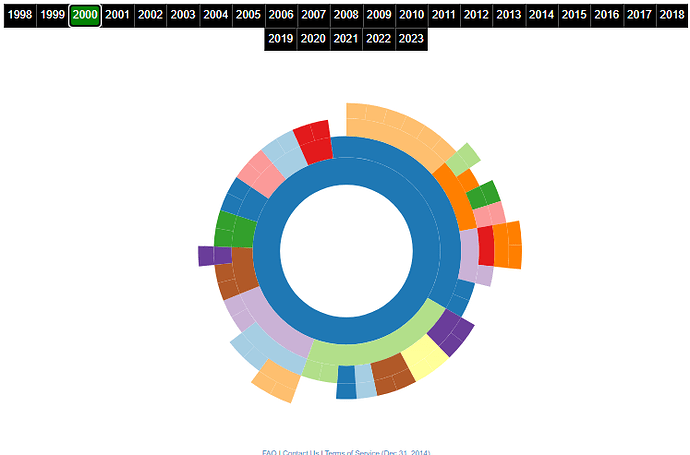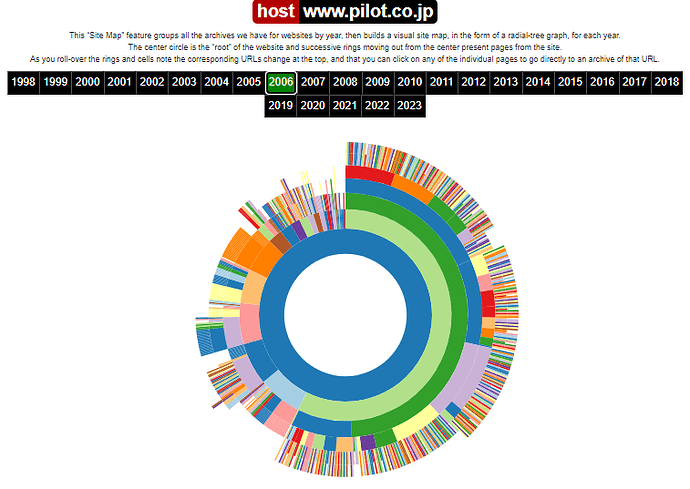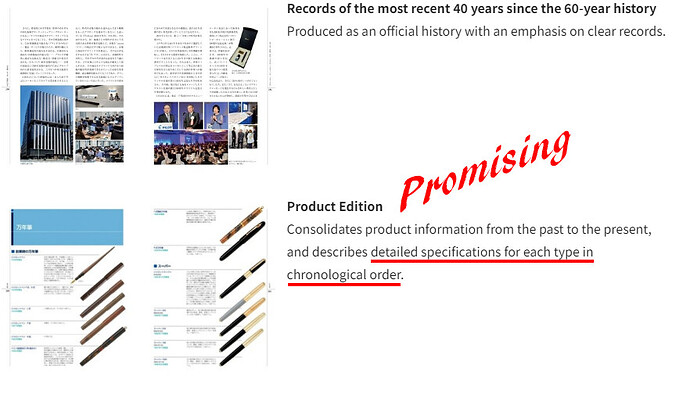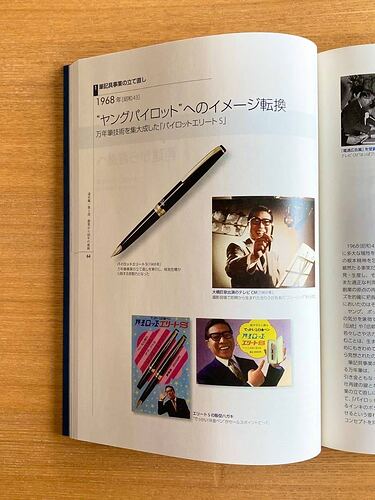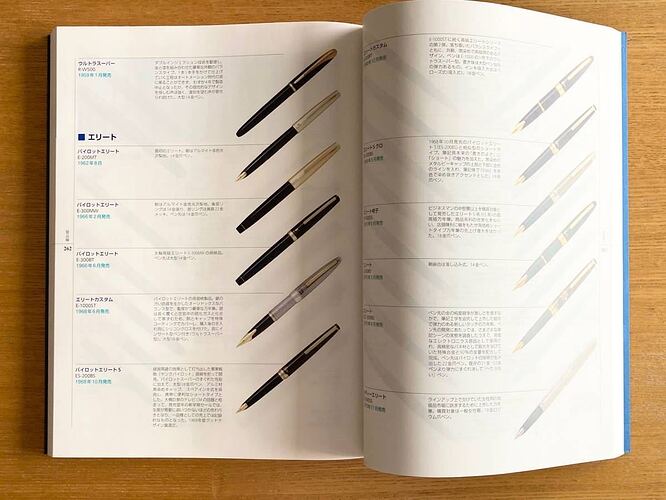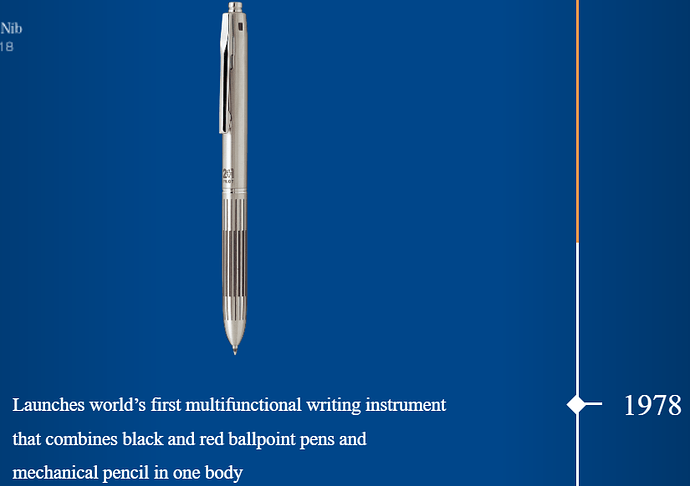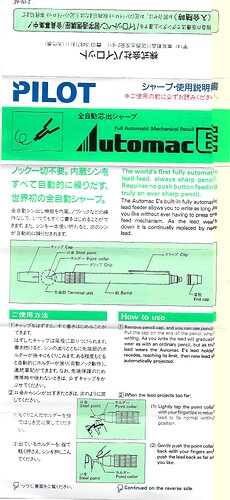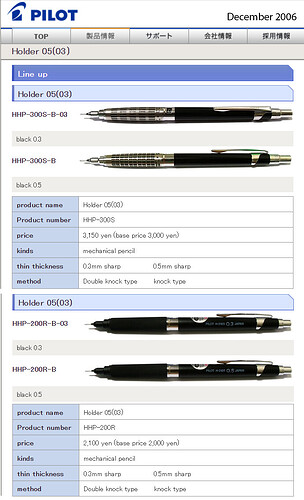Correct me if I’m wrong, the far right one is the Automac-E?
No, not an Automac E. It’s probably not even a PILOT.
LINK
In fact, it looks to be an ink pen of some kind.
It is an unused item with the seal still attached. Part number 364061 0.5mm ink pen is attached as a bonus. New in long-term storage Please also check the photos.
I’m sure it was considered a very high price at that time ![]()
Good point.
At the time, if I remember right, the vintage PILOT Automatic pencils were tending to sell for around 80k JPY. So this wasn’t as “powerful” a deal at the time. The exchange rate of JPY to USD wasn’t very favorable to the USD either.
Speaking of exchange rates… I remember back in 2010 the exchange rate going painfully low for the USD. It was a terrible time to be buying anything of value from Japan.
Given all the chatter that I saw going on about PILOT “hi-mecha” models (H-1005 up to H-3005), it looks like those initial release dates are off a bit. We saw one PILOT catalog from the late 1970’s show an H-2005… which could’ve been a display of a future model to come. But in all likelihood, if the H-2005 (and H-2003) were released around 1978, perhaps the success of it inspired the H-3005/H-3003 and H-2105/H-2103 models shortly thereafter. And then the H-1005/H-1003. My thought is, maybe the lowest of this line being of good enough quality and low enough of a price might’ve helped kill off the more expensive models.
Also, in some later catalogs from the very early 2000’s, someone had said they saw an H-2005 displayed. That suggests that it hadn’t been discontinued in 1995. However, it’s quite possible that since the H-2005 was such an attractive model compared to the H-1005, perhaps they kept it around in the catalog for show, but not as an item that could be ordered. It’s nearly impossible to confirm any of this with PILOT corporation.
With that said, is this still correct?
| MODEL | RELEASE | DISCONTINUED |
|---|---|---|
| H-1005 | 1983 | 2006 |
| H-1003 | 1983 | 2006 |
| H-2005 | 1983 (1978?) | 1995 (early 2000’s?) |
| H-2003 | 1983 (1978?) | 1995 (early 2000’s?) |
| H-2105 | 1983 | 1995 |
| H-2103 | 1983 | 1988 |
| H-3005 | 1983 | 1988 |
Now we have the exact information:
#double knock
ハイメカ2000
1970-08
HH-200K-05 (H-2005)
1970-12
HH-200K-03 (H-2003)
ハイメカ500
1971-07
HH-50K-B-03
HH-50K-B-05
ハイメカ1000
1971-07
HH-100K-B-03 (H-1003)
HH-100K-B-05 (H-1005)
#HP3 (H22x)
HP3
1980-03
HPN-30RK
#H-xx85
ホルダー 03/05
1981-10
HH-50R-L-03 (H-583)
HH-50R-L-05 (H-585)
HH-100S-L-03 (H-1083)
HH-100S-L-05 (H-1085)
ホルダー 05 フレフレ
1981-10
HHF-150S-L (H-1585)
ホルダー 03/05 モクメ
1981-10
HH-200K-M-03/05 (H-2083)
#auto
オートマティック --------------------------- automatic
1983-12
HAT-300S-S
オートマックE ------------------------------- automacE
1988-11
HAE-250R
オートマック --------------------------------- automac
2011-11
HAT-3SR
#2020
ヤング2020 ----------------------------------- young
1978-06
HB-100SF:フレフレ機構
紳士 2020 (フレフレST) ------------------- st
1979-06
HB-200SF
ヤング2020 (フレフレフラッグ) --------- flag
1982-06
HB-50R
2020スリム (2020stスリム) --------------- slim
1982-09
HFT-100S ----------------------------------------- steel
1982-10
HFT-300R ----------------------------------------- lacquer
#S
S3 エススリー
2000-11~
HPS-30R
S5 エスファイブ
2001-8~
HPS-50R
S10 エステン
2001-8~
HPS-1SR
S20 エストゥエンティ
2003-3~
HPS-2SK
S30 エスサーティ
2021-3~
HPS-3SK
Btw, I also post some information about multi pens here
#multi color
細字2色ストライプ -------------------------------- stripe~thick rod
BPK-50SK 1970年6月
細字3色ストライプ -------------------------------- stripe~thick rod
BPK-100SK 1971年6月
細字4色 ----------------------------------------------- slender rod
BPK-300SK 1977年6月
細字3色 ----------------------------------------------- slender rod
BPK-250SK 1977年11月
ホソブト ---------------------------------------------- fine·broad~0.5,0.7,1.0black&0.5red
BPKT-300SK 1979年5月
回転2色ボールペン
BKT-100S 1982年10月
#multi function
2+1 蝕刻 ---------------------------------------------- round head etched 2+1
BPKH-350SC 1977年6月
2+1デラックス -------------------------------------- deluxe~cone head etched 2+1
BPKH-350SK 1980年10月
2+1スタンダード ----------------------------------- standard~cone head 2+1
BKH-250S 1981年1月
1+1 ----------------------------------------------------- round head 1+1
BPKH-250SC 1978年10月
1+1 スタンダード ---------------------------------- standard~cone head 1+1
BPKH-150SB 1979年1月
1+1 ヤング ------------------------------------------- young~plastic grip metal rod
BKH-100S 1982年8月
The information above comes from Pilot’s 100th anniversary book and Twitter user @pentel_six shared us with part of them. I have seen the catalog of this book, the end of the book is an illustrated historical product introduction. In addition to what’s shared above, there are some other types of pen’s content. It’s kind of wordy to introduce the information about the book and the way to get it. So I won’t go deep into it here, anyway, I will try to get a copy of it early next year
edit later: now this book is available here: Supply - Books on Company History
file name: パイロット100年の航跡
it still doesn’t make sense for me, that the automatic came before automace (because of the leaflet https://mblogthumb-phinf.pstatic.net/MjAxOTA4MThfNDMg/MDAxNTY2MTMyOTAyNTIw.1SJOiGqwCROASrN6sHMb4aCMyAcmWj_8QXXLbKK9at8g.wcqPOlNbjpyhMR8DQOaqmC-Om1KJCfXteEBI0XzPqYQg.JPEG.enne313/i-img1200x899-156558244261hfxc1055865.jpg?type=w800 saying it’s world’s first fully automatic pencil). but maybe they meant “fully automatic” as it is used sometimes today for pencils without push knob and with automatic lead transfer.
Fascinating. Who is the author of that PILOT 100th Anniversary book? I wonder if they provide information source credits. Was the book was directly commissioned by PILOT or just a 3rd party effort? A 1970 release date for the H-2003 & H-2005… That would be extraordinary, if actually true. Certainly it would explain the presence of the H-2005 being displayed in a 1979 catalog (4 years before the previously established 1983 release date). If only we could find someone with a catalog from the 1970’s prior to 1979 with a confirmation copy of the catalog page featuring them.
The WayBack machine reference for Pilot.co.jp goes all the way back to 1998.
And yet… the very first instance of the H-3003/H-3005/H-2103/H-2105 is 2006. Its puzzling, until you realize that PILOT was gradually building out the site. WayBack provides a really interesting graphical representation of a website tree, so you can see how it developed. In 1998~2000 PILOT Japan’s website was painfully sparse. In 2001, it just started to fill out.
They’re published by the company officially, the company has a special committee to compile and collect information, in addition, there are professional companies to assist in the above work.
e.g. 会社経営の歴史と製品記録の集大成「パイロット100年の航跡」 | 導入事例 | ソリューション/製品・サービス | DNP 大日本印刷
Excellent detective work. This is fascinating and promising.
I wonder if this will be exclusively in Japanese or if there will be an international edition in English.
Meanwhile, here’s some sort of English worded scrolling version (probably not as detailed as the book): PILOT 100th Anniversary
The main part of this book will focus on the company’s growth rather than the details of the product, and information about pens is at the end (but from the list shared above, it’s clear that only a few products will be on display)
(Some of earlier published books lacked lively images, had little in the way of individual descriptions of the product, and the company found that few people wanted to read them ![]() )
)
I figured that fountain pens would dominate, as that’s the real hallmark of PILOT’s business. So this isn’t a fully comprehensive product guide then?
From the on-line timeline, the first time a pencil (in multi-pen form) appears, is in 1978:
No, simply put, it tells history more from a business or economic point of view than from a product development point of view, as enthusiasts expect
As the world’s first multi function pen (multi color pen was developed much earlier than this) ,etched 2+1 was released in June ‘77 (for sharbo, the first rotate type multi function pen, was released in November’ 77).
There’s nothing wrong with that, I think ‘fully automatic lead feed’ here means the function which feeds the next lead refill without knocking the end of pen.
I know that there is a post in the forum discussing the correct name of each type of pencils, I haven’t replied because I have not spent time specifically researching the official name (by the company or industry), it is enough for me to know the actual function of each pen, so I will do that later
Seems that most people think like this, roughly speaking
semi-auto: those mp work like tk-matic
full-auto: those mp work like e500
So far, I’drather consider those ‘auto’ related pencil this way:
semi-auto: like tk-matic
full-auto: like pn3015
while for pens like e500, I think it’s better to think of it as a derivative of full-auto, or a further development based on that function framework (just like we think of ff-matic as a derivative of semi-auto).
The reason I tend to make this arrangement is that if, according to the first classifying way, all push-matic pencils are classified as semi-auto, is this classification too large considering that push-matic ones have an additional and significantly different operation mode?
This is from functional performance viewpoint, or you can focus on characteristic structure, (still using the name in first classifying way here)
semi-auto corresponds to the one-way locking mechanism
push-maitc corresponds to the self-locking mechanism which delays the reset of lead pipe
full-auto corresponds to a part which lock the one-way locking mechanism, in fact, sometimes it’s basically a spring that can apply pressure to the one-way locking mechanism to make it close when lead pipe was pressed back.
That is, in the absence of an official arrangement, which category a mechanism falls into depends on whether it is considered to be functionally or structurally distinct enough to be a separate parallel category rather than a subcategory. And, is the new feature due to some change in the original structure or is it completely independent of the original one? For example, Dive, during the entire writing process, the pipe will not rub against the paper and you still don’t need other operation. The effect is significantly different from ordinary semi-auto, but since kurutoga mechanism is largely independent from automatic system, I still like to say it’s another derivative of semi-auto.
So there are a lot of personal factors, and the confusion of translation between different languages exacerbates the problem more
Has anyone taken some nice high-resolution photos of all PILOT “hi mecha” double-knock pencil models against a white background? I’d have thought Monogusa would’ve done so, but he was so fixated on the Automatic and H-5005, that it seems he completely ignored any direct focus on the H-2003/2005/2103/2105/3003/3005 series. And in any case, their images are all low resolution.
Unfortunately, PILOT’s own website used low resolution photos on their catalog pages. I tried to substitute better ones. I own only a subset, so I can’t take consistent photos.
Something like this, but higher resolution:
Linus, is there any contact info in that PILOT 100th Anniversary book? Like email addresses for the author or others involved in the book? Or even the names of engineers who designed some of the notable PILOT writing instruments?
